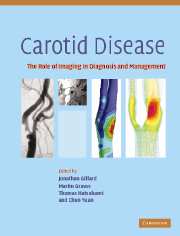Book contents
- Frontmatter
- Contents
- List of contributors
- List of abbreviations
- Introduction
- Background
- 1 Pathology of carotid artery atherosclerotic disease
- 2 Epidemiology of carotid artery atherosclerosis
- 3 Genetics of carotid atherosclerosis
- 4 Hematological processes in emboli formation
- 5 Medical treatment for carotid stenosis
- 6 Surgical management of symptomatic carotid disease: carotid endarterectomy and extracranial-intracranial bypass
- 7 Surgery for asymptomatic carotid stenosis
- 8 Interventional management of carotid disease
- Luminal imaging techniques
- Morphological plaque imaging
- Functional plaque imaging
- Plaque modelling
- Monitoring the local and distal effects of carotid interventions
- Monitoring pharmaceutical interventions
- Future directions in carotid plaque imaging
- Index
- References
4 - Hematological processes in emboli formation
from Background
Published online by Cambridge University Press: 03 December 2009
- Frontmatter
- Contents
- List of contributors
- List of abbreviations
- Introduction
- Background
- 1 Pathology of carotid artery atherosclerotic disease
- 2 Epidemiology of carotid artery atherosclerosis
- 3 Genetics of carotid atherosclerosis
- 4 Hematological processes in emboli formation
- 5 Medical treatment for carotid stenosis
- 6 Surgical management of symptomatic carotid disease: carotid endarterectomy and extracranial-intracranial bypass
- 7 Surgery for asymptomatic carotid stenosis
- 8 Interventional management of carotid disease
- Luminal imaging techniques
- Morphological plaque imaging
- Functional plaque imaging
- Plaque modelling
- Monitoring the local and distal effects of carotid interventions
- Monitoring pharmaceutical interventions
- Future directions in carotid plaque imaging
- Index
- References
Summary
Introduction
Spontaneous plaque rupture, or damage to the vessel wall during therapeutic interventions will lead to the formation of a thrombus at the site of vascular damage. Emboli can be released either as a result of shearing of the thrombus from the vessel wall, or as smaller emboli propagated at the surface of the growing thrombus. In either case the released emboli can lead to downstream vascular occlusion and subsequent ischemia.
Cerebrovascular events related to carotid artery disease are caused in the majority of cases by atherothrombotic emboli dislodging from the carotid plaque (Foulkes et al., 1988; Sitzer et al., 1995; Lammie et al., 1999; Jander et al., 2001). Embolization of platelet thrombus into the circulation is also a well recognized complication of surgical intervention (carotid endarterectomy) or carotid stenting (Riles et al., 1994; Jordan et al., 1999) and is the main cause of postoperative stroke and transient ischemic attack (TIA) (Spencer, 1997). It can generally be considered that embolization that occurs during the dissection phase of carotid endarterectomy is associated with carotid plaque instability, whereas embolic events observed after endarterectomy, following restoration of flow and in the early postoperative period, are related to excessive thrombus formation at the endarterectomy and clamping sites.
Keywords
- Type
- Chapter
- Information
- Carotid DiseaseThe Role of Imaging in Diagnosis and Management, pp. 45 - 58Publisher: Cambridge University PressPrint publication year: 2006

